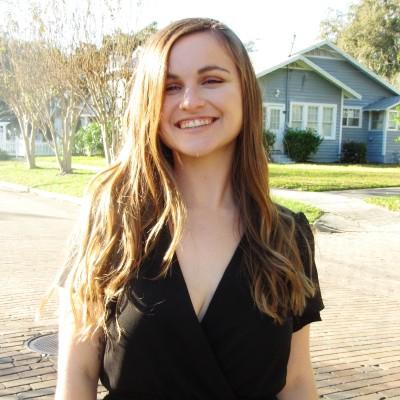Nancy Brown is the Chief Executive Officer of the American Heart Association (AHA) and has been a trailblazing leader for the nonprofit since stepping into the role in 2008. With an impressive tenure of 16 years as CEO and nearly four decades with the organization, Nancy’s dedication to advancing heart health and saving lives is unwavering. Since first joining the American Heart Association in 1986, she spearheaded initiatives that have not only solidified the AHA as a global authority on cardiovascular and brain health but also focused on addressing critical gaps in healthcare – particularly for women.
With the AHA active in over 100 countries and generating over $1.2 billion in annual revenue, Nancy has forged partnerships with more than 40 million volunteers, supporters, and staff. Her efforts have garnered widespread recognition, including being named to Forbes’ 50 Over 50, Modern Healthcare’s 2024 Women Leaders, and NonProfit Times’ Power and Influence list.
Despite women comprising more than half of the U.S. population, women’s health has long been underfunded, receiving less than 3% of the $41 billion in healthcare venture funding in 2023 – according to a Deloitte report. Under Nancy’s leadership, the American Heart Association is tackling this disparity head-on through its Go Red for Women Venture Fund, which Her Agenda learned all about.
Along with Go Red for Women, Her Agenda sat with Nancy to learn about her career with the AHA, her vision for the future of heart health, and why everyone needs to learn how to perform CPR.
Her Agenda: What initially inspired you to pursue a career in the health field? And from there, how did you find your way to the American Heart Association?
Nancy Brown: My mother was a nurse, and my grandfather was a surgeon, and I always knew I wanted to do something to help other people. And you know, when you’re in college and embarking upon a career, there’s so many choices. Initially, I thought maybe I would go into advertising and my background is in communications and marketing.
As I was considering opportunities, it became very clear to me that my own value set wasn’t going to be completely connected to helping to sell other people’s stuff and that I would rather do something that helped people fulfill their potential as human beings. So, I really gravitated to a focus on healthcare.
My very first full-time job – although I worked all through college and had internships – was at a hospital in Detroit where I worked in fundraising, marketing, and PR. Seeing the huge potential to raise awareness about what high-quality health care meant and to raise money to help support access to high-quality health care – it became clear that was for me. Like, I knew right then that it was going to be my calling.
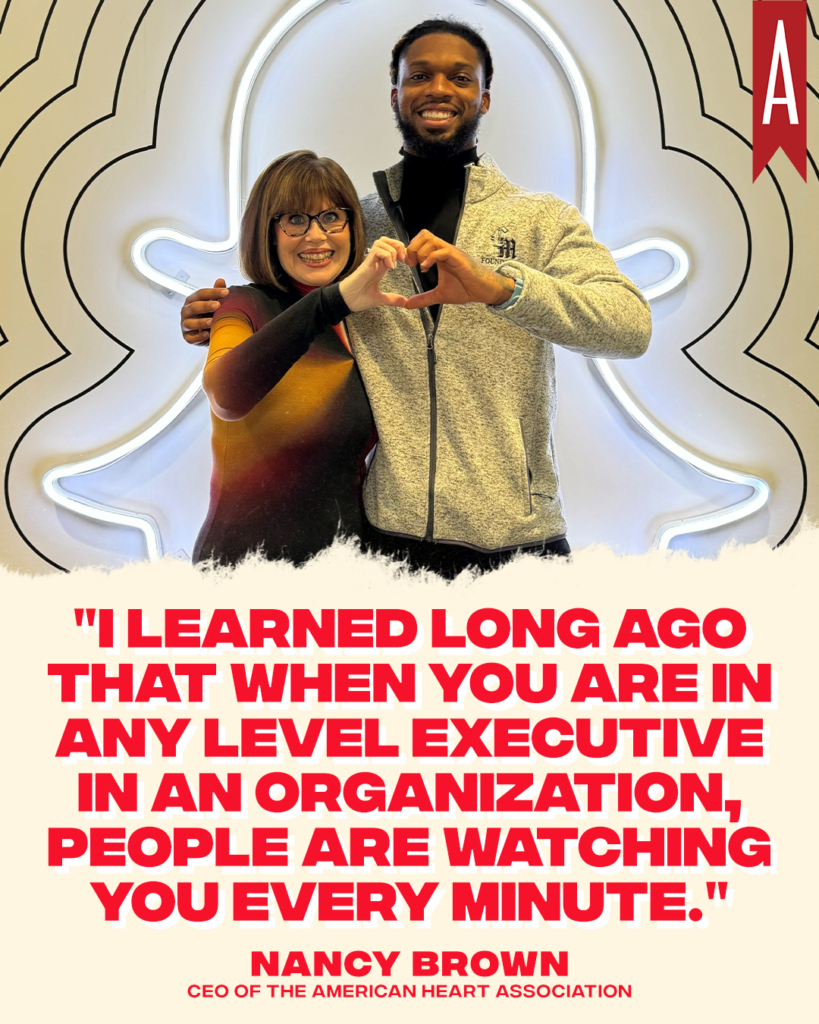
Her Agenda: I love that you just knew. Can you tell me a little bit about the different roles that you’ve had within the American Heart Association and how that led you to where you are today as the CEO?
Nancy Brown: When I first joined the AHA as a young professional, we had 56 separate corporations and the national organization. I joined the Michigan American Heart Association doing fundraising, and I loved my very first job. I always tell people that the best jobs at the AHA I ever had were the jobs in communities. We call it ‘in the field’ in our community work because right there you’re on the ground, helping to connect people as volunteers and donors and in support of the mission of the AHA.
I started there doing fundraising and I was elevated relatively quickly to be the executive director there. Then I moved in 1996 to Massachusetts to become the executive vice president of our standalone Massachusetts affiliate, one of those 56 separate affiliates. So I was kind of the CEO of that affiliate. I went there knowing that the plan was to consolidate the 56 separate corporations into one corporation and it was an honor to be called by our then CEO, Dudley Hafner, to ask me to apply for that job. And there were a lot of people who applied for that job – it was a very highly desirable job to live in Boston and run that affiliate.
But, he asked me to go because he realized that I could be helpful when we were trying to consolidate the affiliate – and I wasn’t even 30 years old yet. I went and competed against some of the very large luminaries in the American Heart Association who were interested in taking on that affiliate, as well. At that time, because the affiliates were separately incorporated but affiliated with the national organization, there actually was a volunteer search committee of the board – nine men and one woman.
I remember very clearly walking into that setting. I did mock interviews and I was so well prepared – I took nothing for granted. I walked into that interview thinking, you know what? I have nothing to lose here. I’m giving it my all because certainly, I was an underdog to get that job. And back in those days, they interviewed everyone on the same day in one-hour increments, and then they called back in the finalists. The two finalists were me and one person from outside of the AHA. I remember as if it were yesterday, the question the volunteers asked me when I came back in.
They’re like, ‘We have one question for you. We have this external person who has all this experience in marketing and revenue generation, and then we have you – and you’ve done this great job. Why should we hire you?’ And I said, ‘I’ll tell you why you should hire me – because I know the art of working with volunteers and other people, and this person from the outside – that’s probably not what they do.’
I was hired, and I got that job and came in as the executive vice president there. Shortly thereafter, we consolidated all of the affiliates up in the northeast into one of 15 unincorporated affiliates, and I became the Executive Vice President of that affiliate. Then in the year 2000, our then CEO – Cass Wheeler – asked me if I would come to the national center and be the Chief Operating Officer. After this consolidation, he was facing a lot of anxiety from the 15 people who didn’t want to give up stuff. Finance, HR – it all needed to be centralized to save resources and be efficient. So, I was hired then as the Chief Operating Officer overseeing all of the corporate business functions of AHA at the national center until 2008 when I was selected to be the CEO.
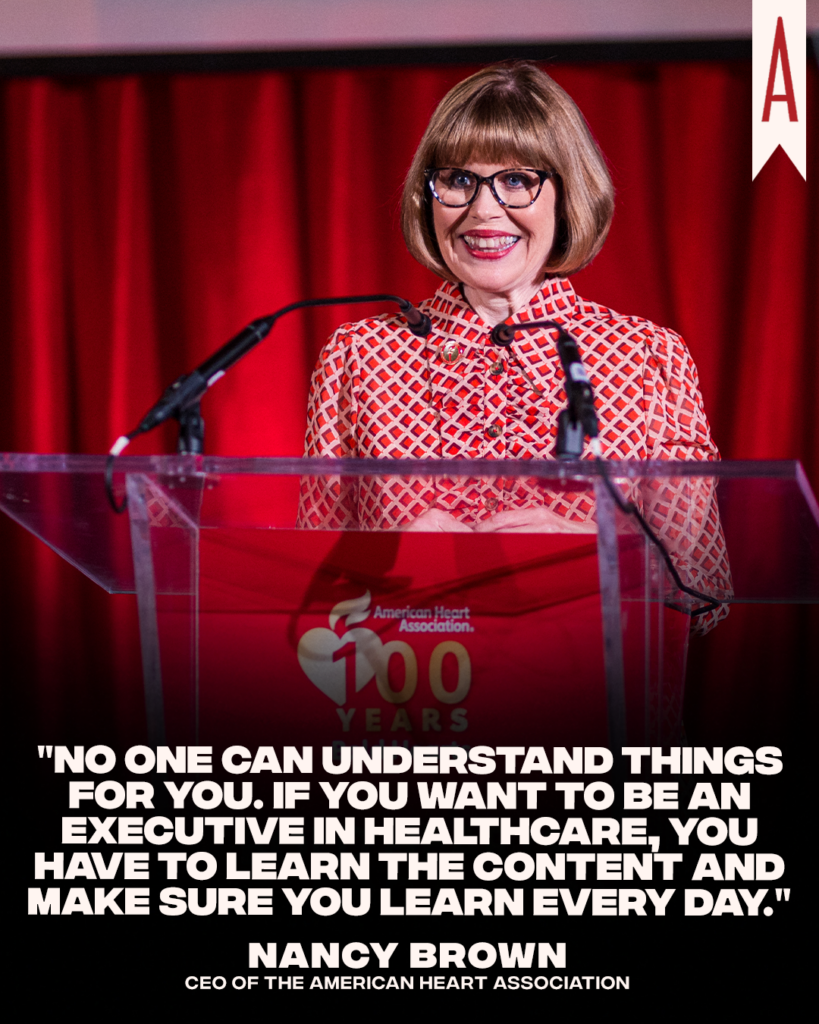
Her Agenda: Did you ever expect yourself to be in this position?
Nancy Brown: It’s funny because that’s a question I get from our staff a lot. When I was in Michigan, no. When I was running Massachusetts, maybe I started to think, ‘I know how I would do things if I were the CEO,’ and that kind of starts creeping in your head. And then certainly when I was asked to become the Chief Operating Officer, I understood very clearly that that was a chance for me to demonstrate my skills, but also to learn.
I always say that Cass did me the biggest favor. A lot of people are like, ‘Oh my gosh, look at this mess that he asked you to come and take care of.’ There were 15 of us – me, one other woman, and the rest were men – but the 15 people didn’t want to give up their autonomy and power, and my job was to convince them to do it and to show how things could be better. So, I took that as a great learning lesson, and I learned so much. I learned about collaboration. I learned about how to involve people in decision-making. So, I always say that getting that opportunity was the biggest gift in my whole AHA career because I really got to know the ins and outs of running a corporation.
Her Agenda: It sounds like you’re doing an amazing job with everything! I know all of your advancements have earned you a spot as one of the top women leaders in 2024 – congrats on that. Can you tell us a bit about the Go Red for Women Campaign?
Nancy Brown: Yes, when I was the Chief Operating Officer, a woman named Kathy Rogers, who now runs our Western region, was our Chief Marketing Officer. We recognized that there was a way to attach our brand to cause marketing more and better than we were doing. We also knew that heart disease was the greatest health threat to women, higher than the next five causes of death combined, four of those five being forms of cancer.
And not that we’re in competition – we want women to have a whole healthy life. But, it is a problem if women don’t understand that their risk of having atrial fibrillation, a stroke, or a heart attack is greater than their risk of various forms of cancer. So, we created ‘Go Red for Women.’ We hired Cone Communications to help us land on exactly the right niche, and we realized that part of the power of the AHA is that we do many things. We have a presence in the community, we do science, we do advocacy, we have a big marketing focus – and we were able to build Go Red for Women to take advantage of all of those vertical areas of the work of the AHA. We created the red dress icon to be the symbol of women and heart disease. We collaborated with the National Institute of Health – which also was very interested in women and heart disease. Fast forward to today, millions of women understand heart disease is their greatest health threat, although generations of younger women still need to be engaged and aware.
So, the campaign continues to evolve. We’ve raised a lot of money to support women’s specific research and advocacy and we’ve created a registry of women who are interested in participating in research, so it continues to grow and evolve. But, it’s certainly a highlight of the success of the AHA over many years, and just in June, we launched the Go Red for Women Venture Fund, which will be a 75 million dollar fund focused on investing in women-specific healthcare solutions – either for women themselves or for clinicians – or the transition of care between physicians, health professionals, and women.
We already have 55 million dollars, so we’re seeking our last 20 million dollars for that fund to be up and running in full force. But, the thing that’s a shame is that of all the money invested in venture capital and health care in 2023, about 2.3 billion dollars – less than three percent of that – was focused on women’s specific healthcare needs. And of that, about 80 percent of the less than three percent is on reproductive health. Of course, we care greatly about reproductive health, but what about heart health, brain health, and mental well-being as it relates to cardiovascular health? So that’s our niche and where we intend to focus.
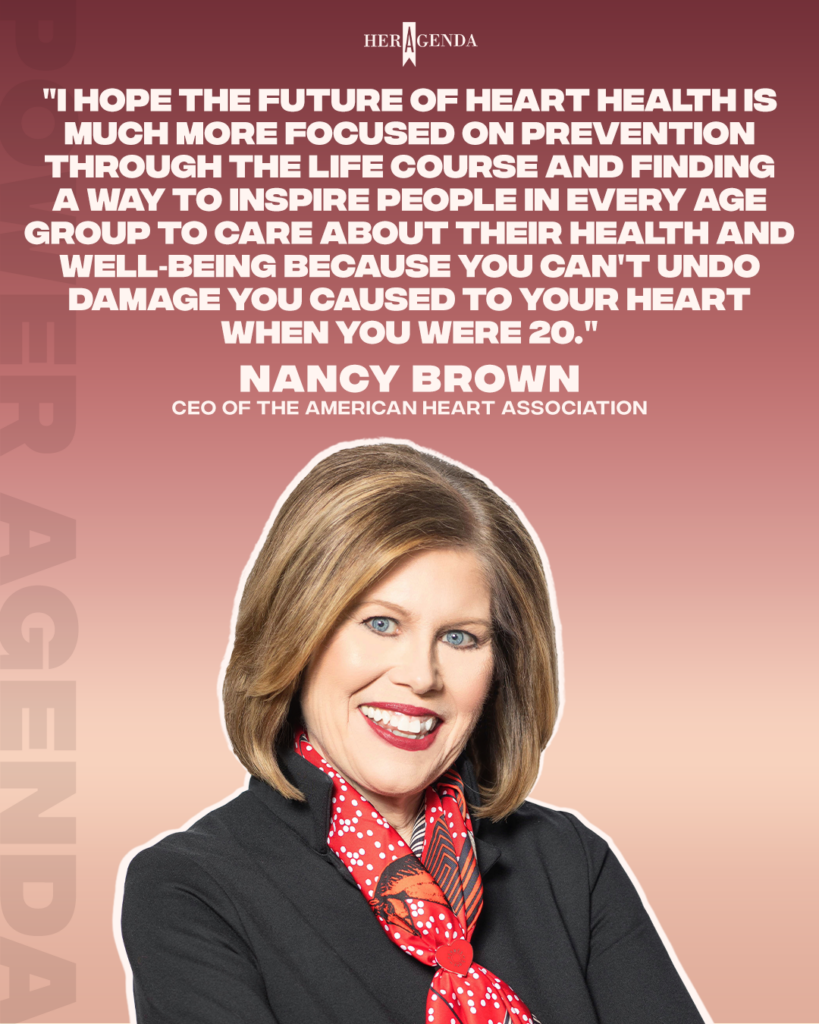
Her Agenda: It’s upsetting to see how little women are considered in healthcare studies. Has women’s healthcare always been something you feel passionate about, or did that start to evolve more as you got further in your career at the American Heart Association?
Nancy Brown: I’ve always been passionate about it because it’s been very clear to me that women are underrepresented and underfunded. Women in my own life, including my sister – who had three strokes from undiagnosed atrial fibrillation in her fifties – people aren’t getting the care they need. She’s getting great care now, but from a prevention point of view, that was missed in her care, and this happens to so many women.
For my entire life, I have seen the underrepresentation of women – whether it’s in corporate boards, executive management teams, and certainly in healthcare for women. It’s been a lifelong passion for me to try to fix that and to do everything that I can to use the platform of the American Heart Association to make this point.
Her Agenda: Can you tell us about any other initiatives or accomplishments that you’re most proud of?
Nancy Brown: One of them is our Nation of Lifesavers campaign, which is making sure that everyone everywhere knows how to do CPR, even if it’s hands-only CPR. CPR is delivered less to women than to men in a bystander fashion. There are about 360,000 people in the United States a year that have an out-of-hospital cardiac arrest, and of that, fewer than 10 percent of people survive – and that is because you only have about 10 minutes to reactivate the blood supply and to get the heart beating again for a person to survive. If you think of bystander CPR, where is it that people might have a cardiac arrest? Some happen in their homes. Some happen in schools and athletic events, workplaces, grocery stores, community settings, churches – and not enough people are trained to know what to do in case of a cardiac emergency, so we’re very focused on this Nation of Lifesavers campaign.
When we’ve surveyed people to understand why is there a disparity of men versus women receiving CPR, it’s actually because of a woman’s breasts. People are afraid they’re going to hurt someone if they administer CPR. The truth is, you’re reviving them and bringing them back to life by administering CPR and using a defibrillator on them. It’s bringing them back to life – so you can’t hurt a person more than they already have been harmed. I’m very thankful to Damar Hamlin, the Buffalo Bills safety who had a cardiac arrest on Monday night football a year ago for being our national ambassador for Nation of Lifesavers. We’re really focused on turning bystanders into lifesavers because you can learn hands only CPR in as few as three minutes, so there’s no excuse for people not to know what to do in case of a cardiac emergency.
We’re doing work in food through our initiative with the Rockefeller Foundation. Food is medicine, and when you think about helping people prevent their chance of having a risk of a heart attack or any sort of cognitive impairment or brain dysfunction, including stroke, we know that food is one of the most important things you can focus on. If you think about how doctors can provide and prescribe medication, why can’t food be covered as a benefit in our prescription programs? So, we intend to create definitive evidence to prove that food, when integrated into the healthcare system and prescribed like medications, can be both cost-effective and effective in improving people’s health.
Brain health is another area we’re focused on because what’s good for your heart is good for your brain – and if you think of your brain and brain capital, it’s one of the most important tools a person has in a knowledge economy. We’re thinking about the things we can do to help people maintain ideal brain health and ideal cognitive function.
The last thing I might mention is our work in cardio-kidney metabolic health. You hear a lot about people who have type two diabetes – yes, they’ve become at risk for having a heart attack, but they also are at risk of having their kidney function not be well. If you’re in a healthcare system right now, these individuals who are at high risk have so many specialists that their care doesn’t get coordinated well. So, we’re trying to bring that together under one umbrella that we call cardio kidney metabolic health.
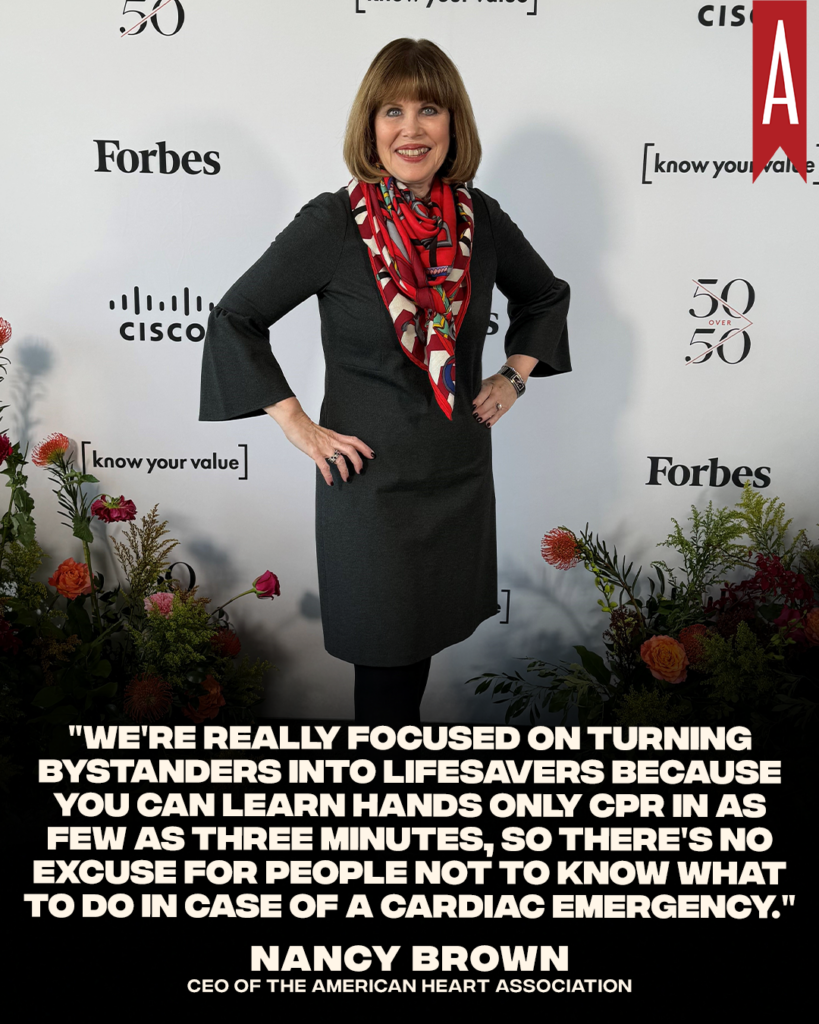
Her Agenda: Going off of that, obviously you are very busy and on the go. How do you maintain a work-life balance, and what does self-care look like for you as a busy CEO in charge of a very large organization?
Nancy Brown: I definitely prioritize self-care, and it looks different every single day for me. It’s impossible with my travel and meeting schedule to be like, ‘Every day at 7 A.M., I do X.’ It’s not that way, but every day I recognize the importance of reflection. Drinking enough water and getting physical activity, and I always try to eat well. None of us are perfect, right? I try very hard to incorporate all of those things into my day-to-day regimen, and there are days where I can get a lot of physical activity, and there are days that if I walk to a bunch of meetings, that’s the extent of my physical activity.
Sleep is something that’s very important as well, it’s what we call one of life’s essential eight. I try my best to get enough sleep, but again, that’s variable depending on flights and travel schedule and those kinds of things, but they’re the things that I focus on and very consciously try to think about.
Her Agenda: You definitely seem like a practice-what-you-preach type of lady.
Nancy Brown: Absolutely. I think the worst thing in the world is for someone to be saying how you need to get more exercise and they take the first parking lot in their parking spot in their office building and take the elevator. I learned long ago that when you are in any level executive in an organization, people are watching you every minute. People watch what you do, who you talk to, how you react, and what it is you say and focus on – and not that that’s why I do the things I do, because I fundamentally believe in health and wellbeing and wellness – but, it sure is not good to be saying one thing and doing another.
Her Agenda: No, definitely. With lots of people watching you – and I’m sure you are an inspiration to many – what advice would you give to young women who want to lead in healthcare organizations like yourself?
Nancy Brown: Number one is you have to be a student because there is no easy way to get from here to there. You’ve got to know the content. Yesterday, I read a 40-page document on Lp(a), which is a form of inherited cholesterol, because I need to know and understand it to be able to be effective in my job. No one can understand things for you. If you want to be an executive in healthcare, you have to learn the content and make sure you learn every day. I read the Wall Street Journal and I watch CNBC in the morning as I’m getting ready to understand what’s happening in business in America today. What are people talking about? What matters to business executives?
The second thing is that relationships really matter. Relationships within an organization, relationships with people you meet – it’s really important to build genuine, caring relationships where you know about people, their life, and their circumstances.
I always think to myself, I’m just the same person I always have been. I might have a job that I have to do when I have to get done that has a certain level of accountability, but no person in an organization is more important than another person in an organization. And I think that mindset really matters. I see a lot of people fail who think that as they move up in the organization, they now don’t have to do X, Y, or Z. If I’m at an AHA event or any event, I’m rolling up my sleeves and helping just like anybody else – and that comes from the heart. That’s what you do. If we have something to get done, we get it done.
Her Agenda: Power can go to people’s heads, so keeping it on that human level and being real with people is so important and underrated. Especially with influences like social media, people can be very transactional – which it does not sound like you are leading in that way at all.
Nancy Brown: At the American Heart Association, we get many things from many people. If you think of the fact that we have 40 million volunteers and supporters, we have so many donors who give their resources so we can do our work – but I never feel like we’re getting from people. Even though in a way we are, I feel like we’re giving to people. We’re giving people an opportunity to connect with other people and to work on a cause that matters. For our donors, we’re helping them fulfill their life’s vision. I was just speaking to someone yesterday about a past president of the AHA who left a large sum of money to the association in his will. Whether it’s him or anyone, people who care enough about what you do to give their money to you – we owe it to people to make sure that we’re good stewards of their money and that we’re helping them fulfill their vision.

Her Agenda: What does the future of heart health look like and what role do you hope the American Heart Association plays in shaping that?
Nancy Brown: That’s a great question. I hope the future of heart health is much more focused on prevention through the life course and finding a way to inspire people in every age group to care about their health and well-being because you can’t undo damage you caused to your heart when you were 20. Suddenly, you’re 50 and you realize, ‘Oh my gosh, I’m at high risk for having a heart attack – what am I going to do?’
What you eat, how much you exercise, the fact that you don’t smoke, the fact that you keep your weight in check –all of those things matter when you get older. So I hope that the risk for heart disease comes way down because we can inspire generations to understand the fact that being healthy is a great thing to do.
[Editor’s note: This interview has been edited for length and clarity.]



